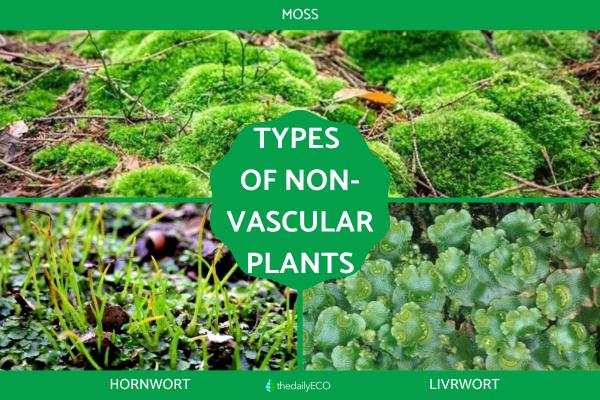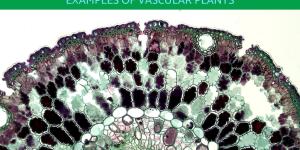Different Types of Non-Vascular Plants


There are various ways in which plants can be classified, but all fall under the category of being either a vascular or non-vascular plant. This is an important distinction because the presence or lack of a vascular system influences the properties of the plant. Most plants which are consumed by humans are vascular, but this does not mean non-vascular plants are unimportant. Some non-vascular plants can be consumed as food, others are important for their medicinal properties or even for use as fuel.
At thedailyECO, we find out more about the nature and characteristics of non-vascular plants. We also share the different types of non-vascular plants and explain their differences in comparison to vascular plants.
What are non-vascular plants?
We could say that non-vascular plants are simply plants without a vascular system, but there are some important nuances when it comes to botanical classification. In botany, sometimes non-vascular plants are considered the following:
- Bryophytes: an informal group of plants that include liverworts, hornworts and mosses. They do not contain vascular tissues, but they do transport water.
- Algae: certain types of algae such as green algae are sometimes included under the grouping of non-vascular plants.
The problem with this grouping is that the different types of algae are not considered true plants. While sometimes they are included in the group of non-vascular plants, they are technically inadmissible. Perhaps the reason algae are often included is because they have characteristics similar to non-vascular plants.
Non-vascular plants lack structures such as roots, stems and leaves. They do not have the vascular tissues which are used to transport water, nutrients and other substances from leaves to roots and vice versa. Specifically, they do not have a xylem or phloem, the tubular conductive vessels which are present in vascular plants.
Although they don't have vascular tissues, non-vascular plants can still transport nutrients. They do this thanks to simpler structures used for water transport, since they have difficulty retaining water in the same way. This is because they are poikilohydric organisms. They have structures that absorb water directly from the environment and move it through their organism, before readily losing it again.
All non-vascular plants have poikilohydry, one of the reasons they are considered simpler organisms than vascular plants. This way of being does have some advantages. They can often survive long periods of drought, resuming normal function after they have rehydrated. Although they are simple organisms, they are one of the most difficult botanical groups to study. This is due to their relatively small size and primitive composition. Despite this, we can find them all over the world, in deserts, jungles, mountains and even at sea level.

Characteristics of non-vascular plants
As we have stated, some consider algae to be a non-vascular plant. Since they are not actually part of the plant kingdom, the following are the characteristics of bryophytes:
- Tissues: the definitive characteristic of nonvascular plants is that they lack conductive tissues, meaning they have neither xylem nor phloem. Discover more about these structures with our article on the phloem and its function.
- Organs: non-vascular plants also lack what are known as organs which include roots, stems and leaves. They do have less developed structures to perform the functions necessary for their development and some can appear as primitive versions of these organs.
- Environment: due to the absence of specialized tissues, these types of plants always grow and develop in humid environments. Thanks to their poikilohydric regulation system, they are able to regulate the accumulation and loss of vital fluid.
- Desiccation: despite being poikilohydric, nonvascular plants tolerate fluctuations in both humidity and temperature fairly easily. This is because many species have the ability to enter dormancy until favorable conditions for their survival arise.
- Distribution: although to a lesser extent than vascular plants, we can find non-vascular plants all over our planet. These range from very dry desert areas to areas with acidic soils and even the Arctic tundra.
- Size: nonvascular plants do not grow to large sizes. They also lack flowers or fruit, making it difficult to identify and differentiate between species. In fact, they generally do not grow larger than 5 cm in height and their coloration is always a striking green.
Types of non-vascular plants
Now we know what non-vascular plants are, we can better understand them by looking at their characteristics. Bryophytes are divided into three main groups:
- Mosses
- Hornwort
- Liverwort
Division Bryophyta (mosses)
Although we consider hornwort and liverwort to also be bryophytes, in its most strictest botanical sense, Bryophyta is the taxonomic division which refers specifically to mosses. Mosses anchor themselves to the ground through primitive structures known as rhizoids. They are typically found in highlands and can grow in both shade and sunlight. Mosses also perform very important functions in ecosystems, such as preventing erosion, facilitating soil water retention and promoting the growth of other plant species.
You can learn more about how different mosses are further categorized with our article asking what are club mosses?
Division Marchantiophyta (liverworts)
Unlike mosses, liverworts lack distinctive structures that help them maintain their grip on the ground. They absorb water and nutrients directly from where they grow. They can grow up to 8" (20 cm) in diameter and have more than 8,500 species within their division. This includes more than 60 distinct families, meaning there are many different types of non-vascular plants. They are also native to humid climates, although some species can also thrive in more arid areas.
Learn more about some individual liverwort species with our article providing types and examples of bryophytes.
Division Anthocerotophyta (hornworts)
Hornworts are so named due to their characteristic sporophytes, horn-like structures that emerge from their surface. Like mosses and liverworts, they prefer moist areas for growth and development. They generally grow in humid areas.
To further expand your knowledge of the Anthocerotophyta division, we recommend reading our related article asking what are hornwort plants?
After learning about the different groups, here are some examples of non-vascular plants according to species type:
- Common hepatica (Anemone hepatica)
- Leafy moss (Bryum argenteum)
- Feather moss (Hypnum cupressiforme)
- Cushion moss (Leucobryum glaucum)
- Water moss (Fontinalis antipyretica)
- Common haircap moss (Polytrichum commune)
- Hornwort (Anthoceros agrestis)
- Thallose liverwort (Riccia fluitans)
- Tree moss (Climacium dendroides)
- Sphagnum moss (Sphagnum spp.)
Sphagnum moss is a non-vascular plant which is very important for professional and amateur horticulturists. We explain why with our guide to sphagnum moss for plants.

What is the difference between non-vascular and vascular plants?
As we have seen, non-vascular plants can be more difficult to study. Despite this, botanists have been able to determine the following key differences:
- Structures: the biggest difference between these two types of plants is that bryophytes (non-vascular plants) are more primitive life forms that do not have plat structures such as stems, leaves, flowers or fruits.
- Function: the main function of non-vascular plants is to maintain and regulate environmental humidity, while vascular plants are one of the main sources of food for other living beings.
- Reproduction: another of the major differences is how reproduction is carried out in non-vascular plants. As bryophytes do not have seeds as do vascular plants, they reproduce by spores and only under favorable conditions. Find out how spores allow for reproduction with our article asking what is sporulation?
- Size and color: bryophytes are easily recognized by their small size and intense coloration, almost always bright green. In contrast, vascular plants have countless and much clearer differentiations between species, such as leaves, stems, flowers and fruits.
- Types: the percentage of nonvascular plants found worldwide is considerably lower than that of vascular plants. Furthermore, they are much more difficult to distinguish due to the similarities and differences between different species.
To further expand your knowledge of how plants are classified and studied, we recommend taking a look at our article looking at the differences between vascular and non-vascular plants in more detail.
If you want to read similar articles to Different Types of Non-Vascular Plants, we recommend you visit our Biology category.







